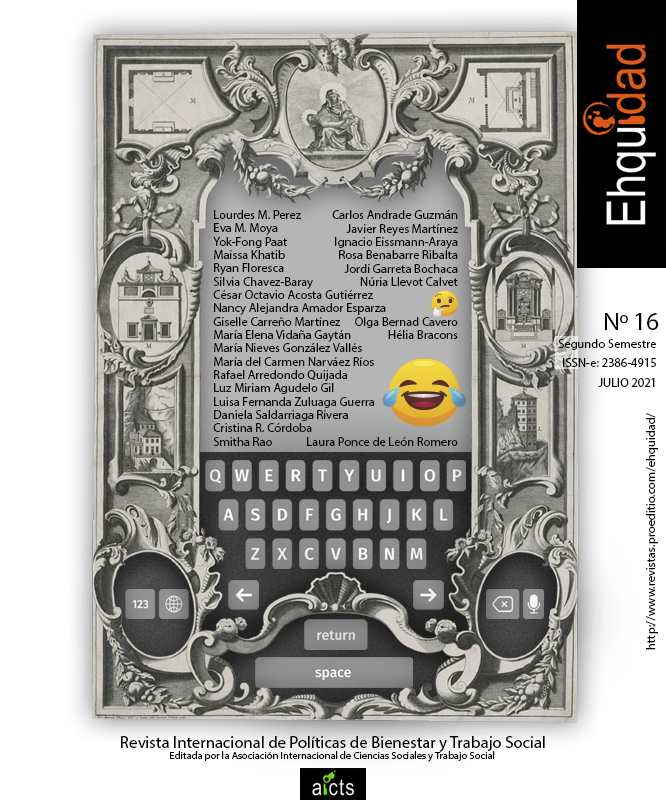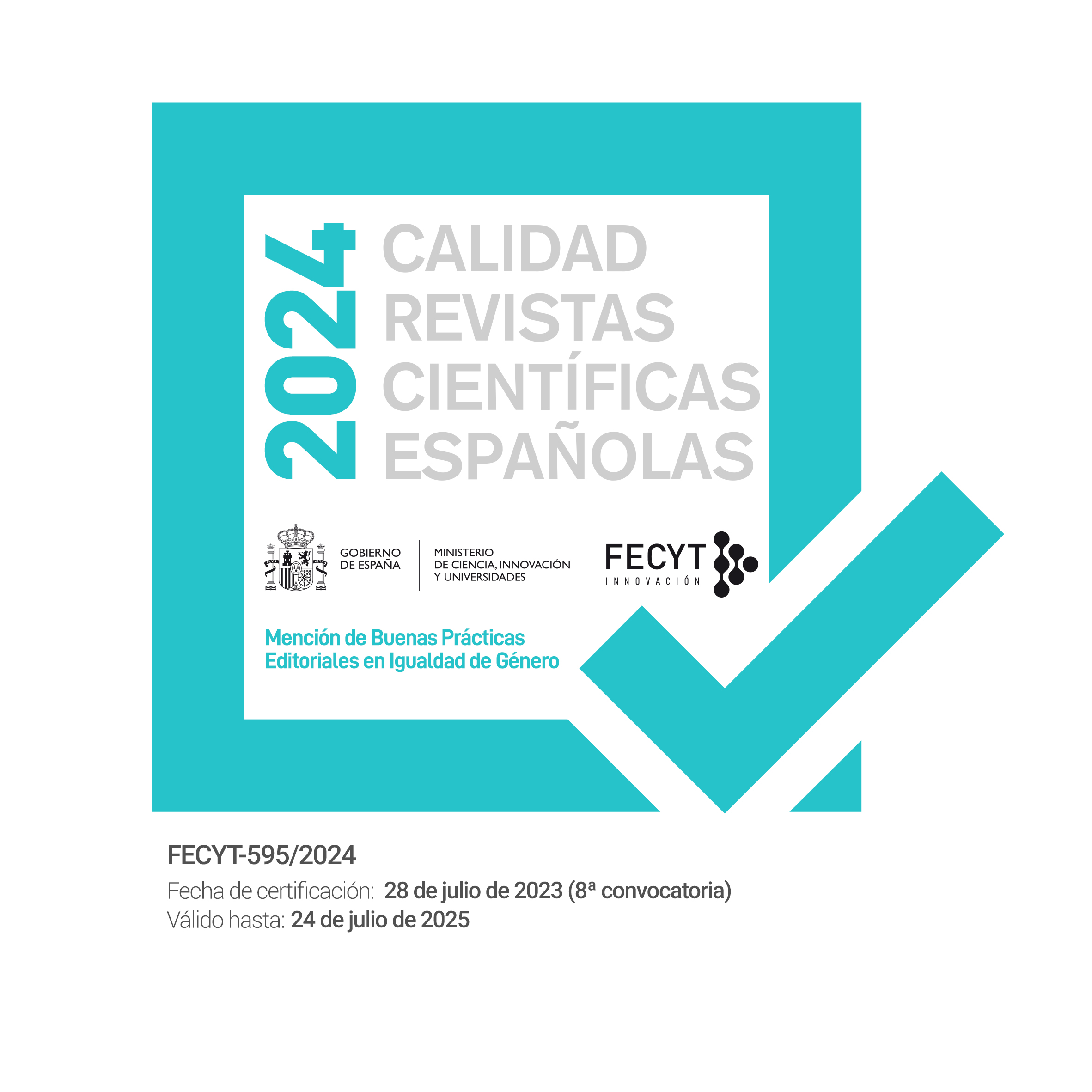Prevention of cyberbullying in secondary school adolescents
A psychoeducational proposal
DOI:
https://doi.org/10.15257/ehquidad.2021.0013Keywords:
cyberbullying, psychoeducation, intervention, proposal, adolescence.Abstract
The Internet has allowed face-to-face relationships to be replicated in a virtual way. However, some of these relationships are not always healthy and are even harmful. This is the case of cyberbullying, which has a high worldwide prevalence in young people, and it is these who suffer the most from its consequences. Cyberbullying victims often have difficulties at school level, feelings of loneliness, fear, anxiety, depression, and suicidal risk. The perpetrators have difficulties in relating, are rejected, are at risk of suffering from anxiety, depression, and suicidal risk, as well as difficulty managing their emotions, low tolerance for frustration, difficulties in resolving conflicts, high justification for violence and low empathy. Programs aimed at preventing cyberbullying tend to be aimed at promoting emotional competencies and have shown favorable results in reducing the justification for violence and participation in bullying and cyberbullying. The present intervention proposal aims to influence psychoeducation in socio-emotional competencies through recreational and artistic activities through a socio-affective perspective of implementation and qualitative pre-experimental methodology with descriptive scope and selection of participants through sampling of homogeneous cases.
Downloads
References
Almario, J. (2016). Una mirada existencial a la adolescencia (2da ed.). Bogotá, Colombia: El Manual Moderno S. A. S. ISBN: 978-958-946.94-2
Andrade, J., Bonilla, L. y Valencia, Z. La agresividad escolar o bullying: una mirada desde tres enfoques psicológicos. Revista Pensando Psicología, 7 (12), 134-149. Disponible en: https://revistas.ucc.edu.co/index.php/pe/article/view/403
Antoniadou, N., Kokkinos, M. & Markos, A. (2016). Possible common correlates between bullying and cyber-bullying among adolescents. Psicología Educativa, 22, 27-38. Disponible en: https://journals.copmadrid.org/psed/art/j.pse.2016.01.003
Aranzales Delgado, Y., Castaño Castrillón, J., Figueroa Salcedo, R., Jaramillo Ruiz, S., Landazuri Quiñonez, J., Muriel Forero, V., Rodríguez Ramirez, A., Valencia Cortés, K. (2013). Frecuencia del ciber-acoso, y sus formas de presentación en estudiantes de secundaria de colegios públicos de la Ciudad de Manizales. Archivos de Medicina, 14 (1), 65-82. Disponible en: https://www.redalyc.org/pdf/2738/273832164007.pdf
Arboleda, Z., Herrera, M. y Prada-Ramírez, M. (2017). ¿Qué es educar y formar para la paz y cómo hacerlo? Educación y Pedagogía para la Paz -Material para la práctica. Bogotá D.C., Colombia: Oficina del Alto Comisionado para la Paz, Acción CaPaz: Estrategia de Capacidades para la Paz y la Convivencia. Disponible en: https://educrea.cl/wp-content/uploads/2019/10/DOC2-educar.pdf
Baldry, A., Farrington, D. & Sorrentino, A. (2016). Cyberbullying in youth. A pattern of disruptive behavior. Psicología Educativa, 22, 19-26. http://dx.doi.org/10.1016/j.pse.2016.02.001 . Disponible en: https://www.sciencedirect.com/science/article/pii/S1135755X16000075
Bar-On, R. (2006). The Bar-On modelo f emotional-social intelligence (ESI). Psicothema, 18, 13-25. Disponible en: http://www.psicothema.com/psicothema.asp?id=3271
Betina-Lacunza, A. y Contini-de-González, N. (2011). Las habilidades sociales en niños y adolescentes. Su importancia en la prevención de trastornos psicopatológicos. Fundamentos en Humanidades, 12 (23), 159-182. Disponible en: http://www.redalyc.org/articulo.oa?id=18424417009
Bisquerra-Alzina, R. (2003). Educación emocional y competencias básicas para la vida. Revista de Investigación Educativa, 21 (1), 7-43. Disponible en: https://revistas.um.es/rie/article/view/99071/94661
Calvete, E., Orue, I, Estévez, A., Villardón, L. y Padilla, P. (2010). Cyberbullying in adolescents: Modalities and agressors’ profile. Computers in Human Behavior, 26, 1128-1135. Disponible en: https://www.researchgate.net/publication/261362739_Adolescentes_victimas_de_cyberbullying_prevalencia_y_caracteristicas
Cascón, F. (2004). Educar en y para el conflicto. Barcelona: Cátedra UNESCO sobre Paz y Derechos Humanos de la Universitat Autónoma de Barcelona.
Colom, F. (2011). Psicoeducación, el litio de las psicoterapias. Algunas consideraciones sobre su eficacia y su implementación en la práctica diaria. Revista Colombiana de Psiquiatría, 40, 147-165. Disponible en: https://www.redalyc.org/pdf/806/80622316010.pdf
Cuba-Esquivel (2016). Constructo competencia: síntesis histórico-epistemológica. Educación, 25 (48), 7-27. Disponible en: http://revistas.pucp.edu.pe/index.php/educacion/article/view/14783/15352
Daza-Navarrete, (2007). La violencia de pares: malestar en la sociedad contemporánea. Tesis Psicológica, 2, 49-57. Disponible en: https://dialnet.unirioja.es/descarga/articulo/3865524.pdf
Ferreira, Y. y Reyes-Benítez, P. (2011). Programa de Intervención en Habilidades Sociales para reducir los niveles de acoso escolar entre pares o bullying. Ajayu, 9 (2), 164-283. Disponible en: http://www.scielo.org.bo/pdf/rap/v9n2/v9n2a4.pdf
Ferrer-Cascales, R., Albaladejo-Blázquez, N., Sánchez-SanSegundo, M., Portilla-Tamarit, I., Lordan, O. & Ruiz-Robledillo, N. (2019). Effectiveness of the TEI Program for Bullying and Cyberbullying reduction and school climate improvement. International Journal of Environmental Research and Public Health, 16, (580). doi:10.3390/ijerph16040580. Disponible en: http://rua.ua.es/dspace/handle/10045/88447#vpreview
Fondo de las Naciones Unidas para la Infancia (2018). School violence and bullying: global status and trends, drivers and consequences. Paris, Francia: UNESCO. Recuperado (el 13 de octubre de 2019) de: http://www.infocoponline.es/pdf/BULLYING.pdf
Fondo de las Naciones Unidas para la Infancia UNICEF (2015). Protocolo en situaciones de bullying. San José: Costa Rica: UNICEF. Disponible en: https://www.unicef.org/Documento-Protocolo-Bullying.pdf
Fondo de las Naciones Unidas para la Infancia UNICEF (S/A). Nueva era del bullying. UNICEF. Disponible en: http://www.aeped.es/sites/default/files/documentos/entrega4_aep_ciberacoso.pdf
Garaigordobil, M. (2011). Prevalencia y consecuencias del cyberbullying: una revisión. International Journal of Psychology and Psychological Therapy, 11 (2), 233-254. Disponible en: https://www.redalyc.org/pdf/560/56019292003.pdf
Garaigordobil, M., Martinez-Valderrey, V. y Machimbarrena, J. (2017). Intervención en el bullying y el ciberbullying: evaluación del caso Martín. Revista de Psicología Clínica en Niños y Adolescentes, 4 (1), 25-32. Disponible en: http://www.revistapcna.com/sites/default/files/16-01.pdf
Gay, L., Mills, G. & Airasian, P. (2012). Educational Research: competences for Analysis and Applications. USA: Pearson.
Gil-Guzmán, B. (2015). Intervención cognitivo-conductual con el niño agresor en un caso de acoso escolar. Revista de Psicología Clínica en Niños y Adolescentes, 2 (1), 25-31. Disponible en: https://dialnet.unirioja.es/servlet/articulo?codigo=4917643
Gobierno de la Provincia de Buenos Aires, Fondo de las Naciones Unidas para la Infancia UNICEF y Faro Digital (2016). Guía de sensibilización sobre Convivencia Digital. Buenos Aires, Argentina: Fondo de las Naciones Unidas para la Infancia UNICEF y Gobierno de la Provincia de Buenos Aires. Recuperado de: https://www.unicef.org/argentina/sites/unicef.org.argentina/files/2018-04/COM-Guia_ConvivenciaDigital_ABRIL2017.pdf
González-Arévalo, B. (2015). Los observadores ante el ciberacoso (cyberbullying). Investigación en la Escuela, 87, 81-90. Disponible en: https://redined.mecd.gob.es/xmlui/bitstream/handle/11162/124932/R87-6.pdf?sequence=2&isAllowed=y
Hidalgo, C. y Abarca, N. (1990). Desarrollo de habilidades sociales en estudiantes universitarios. Revista Latinoamericana de Psicología, 22 (2), 265-282. Disponible en: http://www.redalyc.org/pdf/805/80522205.pdf
INEGI Instituto Nacional de Estadística y Geografía (2017). Módulo sobre cyberbullying 2017 MOCIBA. Recuperado de https://www.inegi.org.mx/contenidos/investigacion/cyberbullying/2017/doc/mociba2017_resultados.pdf
Juvonen, J. & Gross, E. (2008). Extending the school grounds? Bullying experiences in cyberspace. Journal of School Health, 78 (9), 496-505.
Marín-Cortés, A., Hoyos-De los Ríos, O. y Sierra-Perez, A. (2019). Factores de riesgo y factores protectores relacionados con el ciberbullying entre adolescentes: una revisión sistemática. Papeles del Psicólogo, 40 (2), 109-124. Recuperado de: https://www.researchgate.net/profile/Andres_Marin-Cortes/publication/334281751_Factores_de_riesgo_y_factores_protectores_relacionados_con_el_ciberbullying_entre_adolescentes_Una_revision_sistematica/links/5dd54d99299bf11ec866a9ba/Factores-de-riesgo-y-factores-protectores-relacionados-con-el-ciberbullying-entre-adolescentes-Una-revision-sistematica.pdf
Martínez-Vilchis, R., Pozas, J., Jiménez-Arriaga, K., Morales, T., Miranda, D. A., Delgado, M. E. y Cuenca, V. (2015). Prevención de la violencia escolar cara a cara y virtual en bachillerato. Psychology, Society, & Education, 7 (2), 201-212. http://repositorio.ual.es/bitstream/handle/10835/3940/Martinez%20y%20colbs.pdf?sequence=1&isAllowed=y
Martínez-Vilchis, R., Pozas, J., Jiménez-Arriaga, K., Morales, T., Miranda, D. A., Delgado, M. E. y Cuenca, V. (2015). Prevención de la violencia escolar cara a cara y virtual en bachillerato. Psychology, Society, & Education, 7 (2), 201-212. http://repositorio.ual.es/bitstream/handle/10835/3940/Martinez%20y%20colbs.pdf?sequence=1&isAllowed=y
Mayer, J., Salovey, P. & Caruso, D. (2008). Emotional Intelligence: New ability or eclectic traits? American Psychologist, 63 (6), 503-517. Disponible en: http://ei.yale.edu/wp-content/uploads/2013/11/pub172_MayerSaloveyCaruso.AmericanPsychologist.2008.pdf
PantallasAmigas. (2020). Diez líneas de actuación estratégicas para combatir el ciberbullying - PantallasAmigas. [online] Disponible en: https://www.pantallasamigas.net/diez-lineas-actuacion-estrategicas-combatir-ciberbullying/ [Accessed 27 Feb. 2020].
Papadimitriou, G. y Romo S. (2005). Capacidades y competencias para la resolución noviolenta de conflictos. México: McGraw Hill/Interamericana de México.
Quecedo, R. y Castaño, C. (2002). Introducción a la metodología de investigación cualitativa. Revista de Psicodidáctica, 14, 5-39. Recuperado de: https://www.redalyc.org/pdf/175/17501402.pdf
Quintana, A. (2006). Metodología de Investigación Científica Cualitativa. En Quintana, A. y Montgomery, W. (Eds.) (2006). Psicología: Tópicos de la actualidad (pp. 47-84). Lima, Perú: Universidad Nacional Mayor de San Marcos. Recuperado de https://www.researchgate.net/publication/278784432_Metodologia_de_Investigacion_Cientifica_Cualitativa?enrichId=rgreq-5b5c20ecb192b2e7d8fa094d2a326b56-
XXX&enrichSource=Y292ZXJQYWdlOzI3ODc4NDQzMjtBUzoyNDI0NTg3MDk3MjEwODhAMTQzNDgxODA2OTAxOA%3D%3D&el=1_x_2&_esc=publicationCoverPdf
Ramos-Linares, V., Piqueras-Rodríguez, J., Martínez-González, A. y Oblitas-Guadalupe, L. (2009). Emoción y cognición: implicaciones para el tratamiento. Terapia Psicológica, 27 (2), 227-237. Disponible en: https://scielo.conicyt.cl/pdf/terpsicol/v27n2/art08.pdf
Romera, E. M., Cano, J. J., García-Fernéndez y Ortega-Ruiz, R. (2016). Cyberbullying: competencia social, motivación y relaciones entre iguales. Comunicar, 24 (48). Recuperado de: https://www.revistacomunicar.com/index.php?contenido=detalles&numero=48&articulo=48-2016-07
Schultze-Krumbholz, A. Hess, M. Pfetsch, J. 6 Scheithauer, H. (2018). Who is involved in cyberbullying? Latent class analysis of cyberbullying roles and their associations with aggression, self-esteem, and empathy. Cyberpsychology: Journal of Psychosocial Research on Cyberspace, 12 (4). Recuperado de: https://www.researchgate.net/publication/330110554_Who_is_involved_in_cyberbullying_Latent_class_analysis_of_cyberbullying_roles_and_their_associations_with_aggression_self-esteem_and_empathy
Tokunaga, R.S. (2010). Following you home from school: A critical review and synthesis of research on Cyberbullying victimization. Computers in Human Behavior, 26 (3), 277-287. doi: 10.1016/j.chb.2009.11.014 Disponible en: https://www.researchgate.net/publication/222416503_Following_you_Home_from_School_A_Critical_review_and_Synthesis_of_Research_on_Cyberbullying_Victimization
Vargas, D. y Paternina, Y. (2017). Relación entre habilidades sociales y acoso escolar. Cultura. Educación y Sociedad. 8 (2), 61-78. Disponible en: https://revistascientificas.cuc.edu.co/culturaeducacionysociedad/article/view/1731/pdf_260
Weber, N. & Pelfrey, W. (2014). Cyberbullying: causes, consequences, and coping strategies. El Paso, Texas: LFB Scholarly Publushing LLC.
Wilkins, P. (2003). Person-Centred Therapy in Focus. Thousand Oaks, California: SAGE Publications Inc. Disponible en: http://eds.a.ebscohost.com/eds/ebookviewer/ebook/bmxlYmtfXzUxODgzNF9fQU41?sid=129bf47c-b0dd-40ae-864b-da2d07e43669@sdc-v-sessmgr02&vid=3&format=EB&rid=10
Wright, M., Wachs, S. & Harper, B. (2018). The moderation of empathy in the longitudinal association between witnessing cyberbullying, depression, and anxiety. Cyberpsychology: Journal of Psychosocial Research on Cyberspace, 12(4), article 6. http://dx.doi.org/10.5817/CP2018-4-6
Zavala-Berbena, M., Valadez-Sierra, M. y Vargas-Vivero, M. (2008). Inteligencia emocional y habilidades sociales en adolescentes con alta aceptación social. Revista electrónica de Investigación Psicoeducativa, 6 (2), 319-338. Disponible en: http://ojs.ual.es/ojs/index.php/EJREP/article/view/1291/1367












